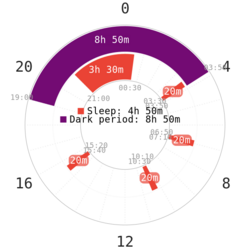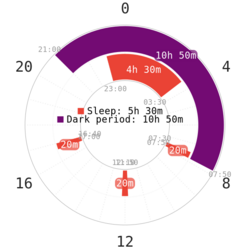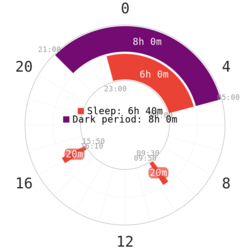Sevamayl
| Sleep EVeryman As Much As You Like | |
|---|---|
| chart link
Legend
| |
| Total sleep | Undefined, but may average around 5-6 hours |
| Proposed by | Aethermind |
| Difficulty | Hard |
| Specification | 1 core, multiple short naps |
Sevamayl is a highly flexible schedule derived from Everyman schedules[1]. It usually evolves from extended variants, such as E3-extended. Unlike with flexed versions of normal schedules, Sevamayl allows taking naps whenever tired throughout the day, with a varying number of naps and occasional changes in core duration throughout.
Mechanism
After adapting to a rigid Everyman schedule, the brain slowly becomes accustomed to a lower sleep total and a napping habit. It then becomes possible to start flexing the naps, with a only a minor decrease in quality. Still, as much of the REM is accounted for by the core on schedules like E3-extended, the main purpose of the naps is to alleviate Sleep pressure and boost alertness. It is also possible to use pronaps to fulfill the REM need, reducing the need for naps later in the day.
Scheduling
A typical Sevamayl schedule contains a core 4-5 hours long, along with 2-6 naps of 10-20 minutes. Cycles may naturally compress with frequent sleeps, often reaching around 80 minutes. Nevertheless, plan for 90-minute cycles until natural wakes become frequent.
Nap spacing should account for natural periods of tiredness. In the evening 6-7 hour gaps are common, whereas gaps in the morning tend to be shorter. A pronap may be used during the REM peak (6-9am) to gain extra time in REM sleep, allowing larger gaps and/or more flexibiliity later in the day.
The core might be flexed and/or occasionally changed in length. It’s not recommended to add or skip cycles more than once a week, it may destabilize adaptations to the reduced sleep total.
Adaptation
While many have attempted, there have been so far no successful cold turkey adaptations to Sevamayl. This may be because the sleep pressure caused from a relatively mild sleep cut on the schedule is not great enough to force the flexible naps to repartition. Spamayl on the other hand has no core, and easily builds the sleep pressure. Because of this, it is necessary to start a Sevamayl adaptation only after successfully adapting to a rigid schedule first.
The most common intermediate adaptation step is E3-extended, but E2-extended is also possible for a 6-hour core Sevamayl. E4-extended should work for people with sleep requirements on the lower side, but it is unclear how flexible a mere 3.5 hour long core will be on an adapted Sevamayl. There are only reports of a few successful E3-flex sleepers where one or two naps were a bit flexible, but otherwise required strict timing. A 3 hour core will likely not work. When comparing the raw nap flexibility of 3 hour versus 3.5 hour core E3, the difference is massive in that the 3-hour core schedules have nearly no flexibility at all.
Once the rigid schedule has been adapted to for at least a month, one should start flexing gradually, slowly building up to the point of varying the number of naps and even slight changes in core placement and/or length. Each increase in nap flexibility of takes time to adapt to, and it is important to adapt to large flexing windows slowly to avoid destabilising the schedule. While adapting to flexible naps, you may feel drowsy around those original nap times, or less able to fall asleep during the moved naps. These symptoms should improve as you adapt to flexing.
Difficulty
Adaptation to Sevamayl requires a stable adaptation to the base schedule, followed by a flexing adaptation, then finally an adaptation to varying the number of naps and potentially core duration. The process is expected to take a long time, up to several consecutive months. Even after adaptation, the schedule requires awareness of current state of sleep pressure and daily planning of naps. As such, the overall adaptation difficulty is considered to be high, despite the relatively mild sleep deprivation incurred.
Lifestyle consideration
Sevamayl fits those with erratic and/or flexible schedules. When used on a strict work schedule, the main purpose of Sevamayl is lost. Moreover, if unused, the ability to flex naps may be lost over time. In those cases, a strict Everyman schedule with slightly flexed nap times, but no variation in nap number or core length, would be more suitable.
It is important to plan your day so you can reach a suitable napping spot when it’s time for a nap, and to also watch food intake and exercise to ensure that the naps have a decent quality.
Once adapted, it is possible to occasionally increase or decrease the length of the core by 90 minutes (or another presumed cycle length). Nap amounts can increase or decrease to help offset the tiredness. After this shortened- or lengthened core, a week should be given to allow the core to remain stable.
Sevamayl is regarded as an ultimate form of polyphasic sleep, allowing many waking extra hours, while also maximizing alertness, without having to stick to any strict sleep times. However, its difficulty lies in the length of time it takes for a successful adaptation, which can take several months to complete. Daily scheduling needs to be stable for the first two or so months, before Sevamayl can be attempted. Then, the adaptation to flexing naps and and changing nap count also takes another month or two, most of which would feel similar to Stage 4, where one feels mostly refreshed, but not quite. Risk of oversleep remains, even as natural wakes become frequent.
Even with its flexibility, it still has many of the weaknesses of reducing polyphasic schedules in general: it can be destabilised by excess sleep due to illness, emotional distress, or when sleeping monophasically due to life circumstances. Severe injury or excessive flexing can also increase sleep needs, causing oversleeps and undo the adaptation.
Variants
While there are no "standard" variants of Sevamayl unlike with strict schedules, there are still different possible variants of the schedule. The difference between them is in the total core length and the overall average number of naps.
The most common core length of Sevamayl is often scheduled to be 4.5 hours. This may naturally decrease to about 4 hours with cycle compression after a long time. Some, especially those with lower sleep needs, may be able to adapt to a 3.5-hour core, but most sleepers cannot gain much flexibility from the shorter core. On the other hand, a 6-hour core is also possible as a less extreme form of Sevamayl, though less popular. The dark period should stay consistent on a day-to-day basis, even if the nap/core timings change, to ensure a stable circadian rhythm.
| E4-extended | E3-extended | E2-extended |
|---|---|---|

|

|

|
Compared to standard Everyman schedules, Sevamayl requires extra naps to be adaptable. While Sevamayl does not have a set number of naps, it still roughly follows the number of naps in the base schedule, as the amount of REM that needs to be accounted for in the naps stays relatively constant. The core should be placed in during the night, and the scheduling range depends on the variant of Sevamayl.
| Core length | Start of core range (solar time) |
|---|---|
| 3.5 hours | 20 – 22 |
| 4.5 hours | 19 – 02 |
| 6 hours | 18 – 03 |
References
- ↑ "Sevamayl". polyphasic.net. Retrieved 2020-11-19.
